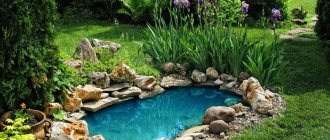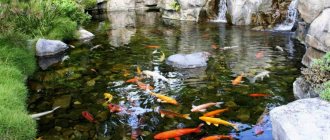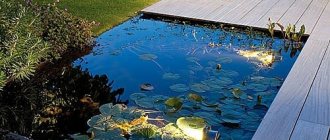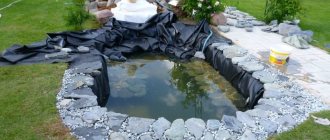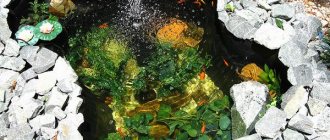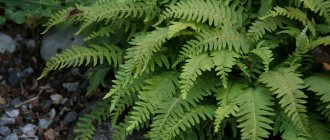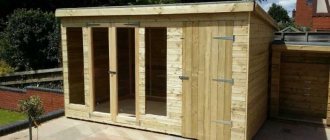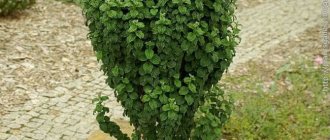A pond is a natural decoration for a summer cottage. It can be built on any area and combined with different styles of landscape design. The coastal area is decorated with pebbles, gravel, plants, an alpine slide and other elements.
What kind of pond can be built at the dacha
Before starting the preparation and actual work on constructing a pond, it is advisable to think about what it is needed for, for what purpose it will be used - for swimming, decorating the landscape, growing aquatic plants, breeding fish, and humidifying the air.
Decorative small ponds are usually included in landscape compositions and are not used for recreation.
Deeper ponds are made in the garden, decorated with bridges or waterfalls, and beautiful lighting. A recreation area with sun loungers, gazebos, and benches is being built on their banks.
You can also swim in large country ponds, and raise fish in small artificial lakes.
In terms of shape and style, country ponds are of two types:
- regular - strict geometric shape or asymmetrical, suitable for landscapes in the style of minimalism, classics, hi-tech, modern;
- landscape - edges of irregular shape, suitable for natural styles and classical landscapes.
You can also build a raised pond on a foundation or with high walls, equipped with a bank fencing.
Ideas for ponds made from scrap materials
Usually, for the construction of an artificial reservoir, different types of film, concrete, and plastic forms are used. But at your dacha you can also make an unusual pond from scrap materials. Suitable for this:
- old bathtub, basin - the container is deepened into the ground, painted and decorated with a fountain or plants;
- tire - they dig a hole the size of a tire from the wheel of a large car, pour sand on the bottom, put a tire with the top cut off on top, and put a covering material on the bottom and sides of the base for the pond, cover the edges (banks of the pond) with sand and decorate with stone, while simultaneously securing the waterproofing ;
- metal or plastic barrel - the container is cut off, dug into the ground, slightly leaving the edges, which are subsequently decorated with rubble and stones, and a small lawn is laid out around it.
The base used to construct the pond affects the durability and appearance of the structure.
Types of ready-made forms
Garden ponds are made from various types of plastic, since this material is waterproof, does not corrode, and is not very sensitive to low temperatures.
- Polyethylene – small reservoirs with a volume of 130 to 900 liters are made from plastic. They are designed for 10 years of operation, are quite durable, and resistant to ultraviolet radiation. However, the material does not tolerate repeated bending, and cracks that occur cannot be repaired.
- Polypropylene - differs from the previous version in being much more resistant to bending. This property extends the life of the product – up to 20 years. Installation is allowed on surfaces with shallow relief. You may also be interested in a polypropylene pool bowl.
- Fiberglass - or fiberglass, a composite material of organic origin. It has very high strength with low weight. Ponds with a large volume and a depth of more than 1.5 meters are made from fiberglass. The durability of the material exceeds 30 years. Fiberglass pool edges are often coated with a stone finish to give the product a more natural look.
Plastic pools not only do not need to be put away indoors for the winter, but it is not even necessary to drain the water from them.
You will find all the information about fish farming in artificial reservoirs here.
Place for an artificial pond on the site
The terrain of the site should be used to locate various landscape design objects, including a pond. On a flat surface, the configuration of the reservoir can be any, and in areas with differences in height, a lake with a waterfall or multi-tiered ponds, as well as slides and bridges, look good.
Also, when choosing a good place to build a pond, you need to consider the following factors:
- free area - if you are planning a large pond, it is important to allocate more space for it, especially if there is a recreation area nearby, so on a small plot you can only build a small pond, and almost any place will be suitable for it;
- soil quality and groundwater level - these parameters affect the depth of the reservoir, the choice of materials that can be used, as well as the complexity of the work on arranging the reservoir;
- illumination - the deeper the pond is planned, the more illuminated area can be allocated for it, but the best option for any artificial reservoir is a shaded place in which direct sunlight falls no more than 5 hours a day;
- power supply - it is good if electric wires run near the place for the pond, as this will simplify landscaping of the area, for example, connecting lighting.
It is also important to consider other natural features. For example, it is good to place a pond in a place visible from the windows of a residential building or from a recreation area. It is also better that bushes and trees do not grow directly near the water, otherwise branches and leaves will pollute it, and the root system can damage the waterproofing of the bottom.
Various unsightly buildings, especially utility buildings, should also be removed from the pond so that they are not reflected in the water surface. To decorate the shore, you can use flower beds in tubs or arrange a lawn and plant low-growing herbaceous plants. All work is recommended to be carried out in spring or early summer.
Turnkey construction of ponds
It is not necessary to resolve all issues related to the construction of a pond or reservoir on your own. To do this, you can contact a team of professionals. For a pre-discussed price, specialists in their field will perform all stages of work on constructing a pond, which include:
- Drawing up a design for reservoirs based on the customer’s wishes;
- Selection and purchase of all materials that will be needed for turnkey construction;
- Development of landscape design for a suburban area, taking into account the arrangement of a reservoir on its territory;
- Construction of an artificial pond or reservoir, taking into account all the features of a particular territory and subsequent waterproofing of the object;
- Installation of special equipment, pumps and cleaning filters;
- Decorating a reservoir using fountains, garden sculptures, plants and other design solutions;
- Consultation with the owner of the land plot on maintenance and regular maintenance.
When ordering the construction and installation of a turnkey pond, the main thing is to contact a trusted construction company that will do its job efficiently and at an affordable cost.
What materials are the ponds made from?
To make your own artificial pond at your dacha, you can use concrete, different types of film, and plastic molds. The most expensive option is concrete. The structure made from it is durable, but difficult to build. It is more suitable not for a decorative lake, but for a swimming pool.
From ready-made forms, which are made from fiberglass and polyvinyl chloride, a pond is built quickly and easily. Such structures last up to 30 years, they are frost-resistant and durable. But they are difficult to deliver to the construction site due to their large weight and size. The disadvantage of this design is the destruction of the material under the influence of ultraviolet radiation.
Films used vary in composition and color. Brown films are suitable for landscape reservoirs, cream and blue films are suitable for pool-shaped reservoirs, and black films are suitable for simulating bottom soil.
To build a pond from all types of films, you need to use durable ones that can withstand the load of a large volume of water, algae, stones, and plant roots. The composition is suitable for this:
- films made of high-density polyethylene are the cheapest, easiest to use, but less durable than other types, therefore they are more suitable for arranging a small pond, the approximate service life is two winters and one hot summer;
- PVC - inexpensive, repairable films, easy to install, not afraid of the sun and frost, but with strong soil movements they do not always withstand the load;
- butyl rubber - synthetic, durable, do not tear when the soil moves, fits tightly to the walls and bottom of the pit, does not crack from frost, does not rot and is resistant to exposure to the sun
The most durable, easy-to-use material is butyl rubber film, which can withstand several freeze-thaw cycles and can be used for 50 years.
Manufacturers
Ponds for summer cottages made from plastic molds are quite popular now, so the choice of manufacturers is quite wide. Not only foreign, but also Russian manufacturers can compete for price/quality ratio. Among them:
- Chris Group has been specializing in the manufacture of plastic products for 18 years. The company's prices are among the lowest on the market, because Chris Group has its own production.
- "Composite Lux" produces foundations for ponds made of fiberglass. It is one of the leading companies in the pool manufacturing market.
- "Your SELIGER" specializes in the manufacture of frame pools and decorative ponds.
- The most popular are German and Heissner.
Pond dimensions
The dimensions of the structure depend on the location where construction is planned. There are no strict requirements regarding size, but you can adhere to general recommendations - the area of the pond should occupy approximately 3 to 10% of the area of the site.
The aspect ratio of the reservoir depends on the configuration, and the depth is selected in accordance with the dimensions. When arranging the pond, it is divided into three parts - shore (10-40 cm), shallow water (up to 1 m), deep water (from 1 m). The last part is needed for reservoirs intended for fish farming. Plants are planted on a maximum of half the area of the reservoir.
Reservoirs with rocky shores
We recently told you how you can use stones and boulders in the landscape design of your summer cottage. And one of the most spectacular solutions is to decorate the banks of the reservoir with them. Thanks to the stones, you will add more beauty to the pond and extend its service life. They will also prevent debris from entering the water. Stones can be taken in different sizes to create a natural effect.
Ponds made of one type of stone, for example, limestone, granite, tuff, look beautiful. You can “dilute” the composition with pebbles or crushed stone. But be careful with sand, it can make the water cloudy.
How to build a pond at the dacha
No special skills or tools are needed to build a pond. But it is important to choose a configuration of an artificial reservoir that will fit into the surrounding landscape both in style and size. Depending on this, as well as the construction budget and personal preferences, the material from which the pond bowl will be made is chosen.
In terms of practicality, ease of installation and the variety of shapes and sizes of the reservoir that can be built, the best option is film. It is not difficult to build a pond from a ready-made plastic bowl, and if you plan to use it for swimming, the bottom and walls of the bowl are often made of concrete.
Film pond
The amount of material for work is calculated as follows:
- pond length + 2 depths + half a meter (reserve) - film length;
- pond width + 2 depths with the addition of 50 cm - width.
Adhesive tape is used to hold the film parts together. Before work, draw up a sketch of the future reservoir on a sheet of paper. It is advisable to mark on it the location and depth of the shelves for plants. Then the sketch is transferred to the ground.
Create a contour using a hose
After this, the work order is as follows:
- At the place where the pit should be, remove the soil according to the markings, dig a hole 60-70 cm deep, starting from the edge. Clear the bottom of excess soil, roots, and debris.
- Compact the bottom and walls of the pit, giving the desired shape.
- Spread the film on the bottom and walls of the pit, leaving small folds. This is important, since during operation the material can become very stretched and tear.
- Leave the film in the sun for 2-3 hours.
- If the surface of the pond is large, several stones can be placed in some places, especially at the joints.
You can also fill the bottom and walls completely with them. If you plan to decorate the pond with plants, then you need to pour sand on the bottom and add loam on top.
The soil layer depends on the selected plants and ranges from 15 to 40 cm. - Plant bottom plants, gradually fill the pit with water, pouring it in a thin stream. Any algae that has not taken root should be covered with gravel.
- Leave the water for 2-3 days, and then cut off the excess film, pour a layer of sand on the ends, securing the ends of the material and shaping the shore.
Unfortunately, not everyone understands that a real body of water is not just a hole in which water stands. A real pond or lake is a body of water with a healthy ecosystem, which, if properly maintained, regulates itself and develops itself. This is a living organism with its bacteria, flora and fauna, a small world inhabited by hundreds of living organisms.
Only in this case will water be able to bring you joy for many years, pleasing the eye and body with its mirror-like surface. But how can you understand that in the desired place you will get just such a healthy body of water, and not a simple puddle of stagnant water?
Where to make a natural lake or pond?
To put it very simply, the main thing is to find this very water. That is, to find out the presence of water-saturated soil layers on the site. You are unlikely to cope with this matter on your own; it is worth involving professionals in such an event. If the water-saturated layer found is not active enough and the required amount of water does not pass through it in a certain period of time, then most likely the water in the pond will not be renewed in the future. Poorly saturated with oxygen and essential minerals, it will begin to stagnate, which means that after a while it will turn into a blooming puddle. If the site is located in a river floodplain, this is, of course, a good sign.
But, if you see only dry fields around, then the likelihood that a reservoir can be created here is extremely small. Except if there is no aquifer at this place. In this situation, it is possible to form a source that will feed the reservoir.
That is, the main principle of organizing a healthy pond is the factor of constant water renewal. She needs a rich saturation of oxygen and minerals. Only in this case will the lake ecosystem be able to function and develop properly.
How to choose pond sizes?
The next important factor in the healthy functioning of a pond is its size. Firstly, it’s worth calling a spade a spade: any professional will tell you that a 100 m2 body of water is a puddle, not a lake. Such a pond can never be a living organism; the necessary plants will not develop in it, and the water will not be saturated with oxygen. And quite quickly such a body of water will “bloom”, turning into a fetid, green slurry. For natural, healthy development, a reservoir needs a decent displacement. Therefore, when designing a pond, the first condition that should be set is its depth and area of the water surface.
Moreover, the main thing is that the depth of the reservoir should not change over the years. It is this that determines whether your pond can function as a living organism. And the less often you have to carry out measures to restore its depth in the future, the better the quality of the pond was originally made. For the most part, it is the sufficient depth of the pond that guarantees that it will not bloom soon. The fact is that a small layer of water quickly warms up under the rays of the sun (in our latitudes this is about one and a half meters). Strong heating of water is the main reason for the irrepressible growth of aquatic plants. Ideally, there should be at least a meter of cold water under the water column, to which the sun’s rays reach little.
This way you can protect your lake from outbreaks of flowering and overgrowing of its mirror with green grassy “turbidity”. In addition, it is at depth that fish winter, where the microclimate they need is formed.
The main condition is that the area of the water surface must always be proportional to its depth. There are deduced patterns of the angles of the slope of the reservoir basin, under which water-saturated soils are laid. Based on this knowledge, it is possible to calculate at what angle nature, for example, in a year, will place a layer of clay, sandy loam, clean sand or loam on the bottom of the lake and its shores. To do this, at the stage of developing the design work for creating a natural lake, it is worth making a geological section. Having its results, it will become clear what soils will have to be dealt with, which soils perform the function of hydraulic resistance, which are water-bearing, and which are fertile. Only after this can you decide how deep it is worth making a pond in the desired location, and indeed whether it is possible to create a living, healthy, self-developing pond in this place. Or, on the contrary, in a year your lake will definitely turn into a pit filled with stagnant water.
Another important factor is the presence of deep and shallow parts in the reservoir. When creating a pond, take this into account - it is better that the deep-water part be shifted to the south of the lake, and the shallow part to the north.
What will be needed to build a pond?
First of all, you will need professionals who can evaluate the feasibility of creating a pond in the desired location. After conducting several analyzes and assessments, they will be able to answer the main question - is it possible to create a healthy body of water here that will delight its owners for many years. Don't try to save money on them. By drawing the wrong conclusions on your own, you risk spending a lot of money on the delivery and rental of the necessary special equipment and workers, and in the end find out that the coveted pond right here and now is an impossible dream.
If you have received the go-ahead from experts to build a lake, you, as mentioned above, will need certain special equipment - you will definitely need an excavator and a dump truck.
If your site abuts a swamp, thick reeds and reeds, where there is high groundwater, or there is an open water source, then you will need a long-armed floating excavator and preferably the same floating dump truck. There is little such equipment in Ukraine, but companies specializing in creating natural reservoirs exist. Try looking for them on our message board. Sometimes a bulldozer and loader may also be needed to clear the area.
If the pond is “sick”
Quite often you can hear complaints from pond owners that their pond, or an existing natural reservoir located on the site, is beginning to show signs of ill health. A musty smell, poor water quality, overgrowth of aquatic plants, silting of the bottom and death of fish are signs that the natural ecosystem of the reservoir is disturbed. Sometimes the reasons that cause such phenomena are natural. For example, a very dry summer season can lead to a significant drop in water levels, and this in turn initiates changes that are invisible at first glance, but which over time will result in serious problems. Or, on the contrary, excessive rainfall can cause the growth of organic matter in the water, which over time will begin to decompose and leave the water without proper oxygenation.
Sometimes you will see that unsightly muddy sediment has suddenly begun to accumulate at the bottom of the pond. Enriched with organic matter, the decomposition of which causes the release of fetid hydrogen sulfide, it will contaminate the lake, leading to the development of putrefactive processes. Such silt is called putrefactive, and it appears as a result of the death of aquatic plants.
Often, the owners of such lakes decide to deal with silt using a simple method - dredging with the help of special equipment and dredgers. By removing the silt from the bottom, they think they have solved the problem. But soon the realization comes that this method brought only temporary relief; the bottom of the pond was again covered with black silt. And this is no wonder, since increased bottom sediment is not a disease, but only a symptom of poor aeration (oxygen saturation) of water. And this could happen for this reason.
All living organisms on our planet cannot survive without oxygen, and they also require certain nutrition. If your body of water is not recharged with new water, and is also not deep enough, and its water column is almost completely heated by the sun, it will begin to experience active blooms of blue-green algae, a type of phytoplankton. These tiny organisms will consume all the oxygen as they grow, thereby causing the death of beneficial aquatic plants. So the results of their decay will be deposited on the bottom of the lake, and after them the fish will die. If this problem is not solved, the lake may turn into a stinking puddle where you will never be able to swim or fish at dawn.
A solution to the problem may be to change the configuration and size of the pond. But if you can’t do this, then today there are other methods of dealing with this problem. Professionals (hydrobiologists), having taken samples of water and algae, will be able, for example, to advise introducing certain types of fish into the pond that can destroy the “greens” simply by eating them. Or, perhaps, you will be offered to use an artificial aeration system - a method that allows you to control water quality and the growth of aquatic plants. Such systems can be electric or powered by solar energy. Both will be able to artificially saturate the lake with oxygen, pumping it with special diffusers. Such aeration systems ensure continuous and effective oxygenation of lake water all year round.
However, sometimes this may not be enough to maintain the health of the reservoir. Often, to “cure” a large pond, experts may recommend combining artificial aeration with “bacterial therapy,” during which beneficial microorganisms will populate your pond.
This two-phase approach is the most effective and cheaper option than completely redesigning the configuration and size of the lake. Without using the right approach to “healing” the reservoir, you will have to do dredging work again and again, without getting the desired result. Therefore, our advice to you is to contact specialists - in the end they will save you both the lake and your money.
How to decorate a pond
To make an artificial pond look natural in the landscape, its banks can be decorated with plants and stones. Sloping areas or terrain with changes are ideal for creating a waterfall.
If the area allows, you can set up a recreation area next to the water with a gazebo, mini beach, benches, beautiful plants, and garden figurines.
To decorate a pond, they usually use:
- plants (Water lily; Pontederia; Eichornia; Pistia; Canadian Elodea; Floating pondweed; Floating chilim; Common water lily; Yellow egg capsule; Arrow leaf), planted in containers and placed on specially equipped ledges in the pit;
- flowers in tubs placed on the shore;
- a large stone, boulder located in the center of the pond;
- lay beautiful stones on the bottom, walls, and on the shore;
- lay paths from the reservoir from wood cuts, gravel and other natural materials suitable for paving;
- build a bridge across the pond, install a fountain;
- make railings and fences along the shore;
On the shore, you can also make lighting from LEDs or place lights in transparent glass balls that protect the wiring from moisture, right on the water, using a weight.
Manufacturing options
There are only three types of water body construction on the site:
- On a rigid basis, by concreting the pit.
- By installing a polymer container in a pit.
- Using a special film.
Rules for caring for an artificial pond
In order for an artificial pond to last longer, you need to choose the right material and follow the installation technology. It is also important to properly care for it during operation, to hide equipment, fish and plants for the winter.
To prevent the water from becoming polluted, it is not recommended to lay peat and black soil soil on the bottom, remove dried plants in a timely manner, and protect the pond from fallen leaves using a special mesh on the frame.
To prevent the pond from blooming, during hot weather you need to add cold water and maintain it in a slightly acidic state. To feed coastal and aquatic plants, it is better to use slow-soluble, long-acting fertilizers rather than spray solutions.
dizlandshafta
Where to dig
Small artificial reservoirs are best viewed from above. Therefore, if there is a corresponding depression on the site, it is best to do it here. There is, however, a negative side to this: you will have to raise the edges of the bowl higher so that rainwater does not get inside. The second option is to come up with a water drainage system (make a drainage system above the reservoir).
If there is a key somewhere on the site, it is logical to make a natural pond by digging or deepening the existing bowl, lining its borders with cobblestones or stones, and planting plants. The stream, which is sure to exist in this case, can also be improved by lining its edges with cobblestones, drowning them in the soggy soil, you will give greater strength to the bank, and you can plant moisture-loving plants between them.
Covering the bank with stones will prevent soil from being washed away.
Even a small waterfall is a magical sight
How to dam a pond if there is a natural stream on your site - dig a pit, cover it with stones and direct the stream into it
How to make a stream if you don’t have one on your site
Not everyone has such a luxury on their property as a stream or a spring. We have to make artificial reservoirs. When properly designed, they look no worse than natural ones.
Compact reservoirs of strict geometric shape
The clear geometric shapes of the reservoir emphasize its artificial origin. But this is an excellent option for small areas where there is no room for large ponds. And it will be much easier to care for such a reservoir. Therefore, do not deny yourself the pleasure of making a small water corner with your own hands.
Even the smallest body of water can be dangerous for children and animals. Therefore, think over a fencing system and firmly secure the stones. In one of the places of the pond, be sure to make a gentle descent.
Ponds with waterfalls
Waterfall is one of the fashionable trends in modern landscape design. This composition looks fantastic. But it is important to correctly fit the reservoir with a waterfall into the environment. Otherwise, it will not be a very good solution. Additionally, LED lighting or underwater lights can be installed at the bottom of the reservoir.
